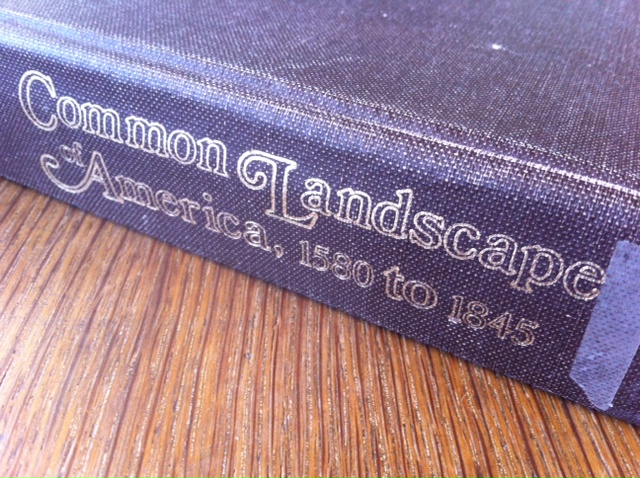If you like learning about the underlying structures that shape the physical, economic and political landscape of our country since day one, then I have a book for you: Common Landscape of America, 1580 to 1845 by John Stilgoe. As alluded to in an earlier post, the book provides timeless insight into the collisions of culture that continue to shape the contemporary American experience, right up to yesterday's 2013 Presidential Inauguration Ceremony, and, I dare say, the most recent TV or newspaper story you watched or read today.
 John Stilgoe's Common Landscape of America, 1580 to 1845, is a classic book and required reading of all first year students at the Harvard Graduate School of Design.
John Stilgoe's Common Landscape of America, 1580 to 1845, is a classic book and required reading of all first year students at the Harvard Graduate School of Design.
I've got an architectural watercolor rendering to do today (Yay!) so I'll keep my part of this post short, but check out the excerpt below from the chapter on the history of schoolhouses on the subject of a book written by Jedidiah Morse in 1789 called The American Geography.The book was an off-the-charts bestseller which coincided with the growing movement, eventually mandated by the "tyrannical" federal government, to educate all American children in communal schoolhouses, almost always one-room affairs which have a fascinating history relative to where they were built (usually the most central place, or on a piece of waste land donated by a farmer, but almost invariably in the most difficult-to-get-to and foreboding locations within each school district). Due to its fortuitous timing, the book had perhaps a disproportionate influence on the opinions of generations of young Americans, and is even given credit for much of the misinformation which started the California Gold Rush of 1849.
As Stilgoe sets it up: "Topographical knowledge no longer only derived from topographical experience: Morse filled his books with maps, charts and lengthy prose descriptions of states, regions, rivers, territories, forests, soils and agricultural and mineral riches...Morse emphasized that his information was scientific and reliable, and schoolmasters commanded students to memorize it. Scholars learned that New Hampshire was filled with mountains and cascades, that North Carolina "abounds with medicinal plants and roots"...and that the Spanish Dominions truly needed American improvement."
Now here's where it gets crazy (and racist) and illustrates how these powerful early memes persist to the present day:
Morse writes: "The characteristics of the Californians are stupidity and insensibility (18th c. snap!); want of knowledge and reflection; inconstancy, impetuosity and blindness of appetite; an excessive sloth and abhorrence of all labor and fatigue; an excessive love of pleasure and amusement of every kind, however trifling or brutal; pusillanimity; and, in fine, a most wretched want of everything which constitues the real man, and renders him rational, inventive, tractable, and useful to himself and society."
Stilgoes sums it up: (according to Morse) "Californians neglected rich soil, a productive climate, a valuable pearl fishery, and mines of gold of 'very promising appearance' to sleep in the sun. Morse prepared thousands of American school children for the gold rush of 1849, for the great rush to the land where 'there falls in the morning a great quantity of dew, which settling on the rose leaves, candies, and becomes hard like manna, having all the sweetness of refined sugar, without its whiteness,' for the great rush away from well-known neighborhoods and farms to lands imagined first in books, not oral tales. Inside every schoolhouse tradition clashed with invention and imagination; almost always tradition lost to the invention and imagination recounted and inspired in books."
There are gems like this on every page. Run to your library and pick up a copy.
(The author, un-noted book critic and accidental historian James Akers, specializes in digital architectural rendering, watercolor techniques, traditional architectural rendering, architectural watercolor rendering, architectural sketching, watercolor rendering techniques, architectural sketches, watercolor techniques, architectural rendering and the other disciplines associated with traditional architectural rendering. He may be reached at jakers3 (at) gmail (dot) com.)